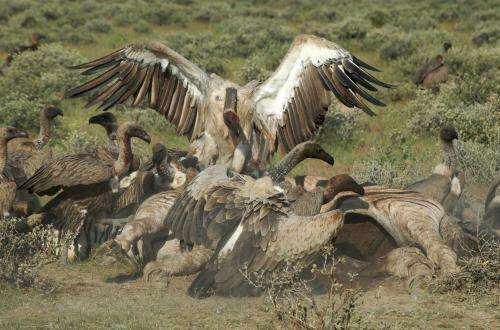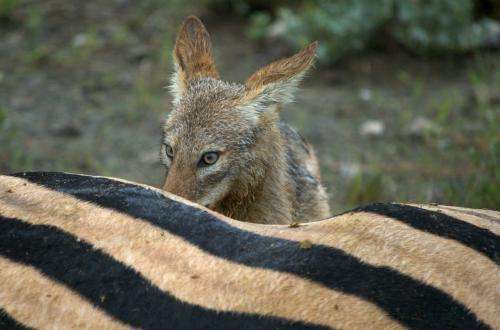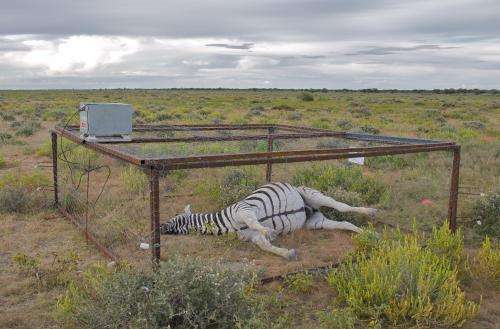Scientists cage dead zebras in Africa to understand the spread of anthrax

Scavengers might not play as key a role in spreading anthrax through wildlife populations as previously assumed, according to findings from a small study conducted in Etosha National Park in northern Namibia.
Wildlife managers currently spend large amounts of money and time to control anthrax outbreaks by preventing scavengers from feeding on infected carcasses.
The effort might be ill spent, according to results published in Applied and Environmental Microbiology by an international consortium of researchers led by Steven Bellan, an ecologist at The University of Texas at Austin.
Carrion produced by anthrax deaths feeds many scavengers, including jackals, hyena, vultures, marabou storks and occasionally even lions. These scavengers have evolved to be able to digest infected carrion without contracting the infection. Herbivorous animals more vulnerable to anthrax include zebra, springboks, elephants and wildebeest.

It has been thought that scavengers change the environment in which the anthrax bacteria are living by opening herbivores' carcasses, enabling more production of spores—the infectious life stage of the anthrax bacteria.
"The hypothesis is that when a carcass is intact, the anthrax bacteria are forced into a kind of death match with putrefying bacteria from the gastrointestinal tract," said Bellan, a postdoctoral researcher in the lab of biologist Lauren Ancel Meyers. "But when the body is opened to the air, either by a scavenger or the hemorrhaging from all bodily orifices that occurs at death, the anthrax bacteria can escape that competition and more successfully produce spores."
According to this hypothesis, the scavenging also allows the carcasses' bodily fluids to leak into the soil, leading to more spores contaminating the soil. Combined, this might increase the likelihood of spread to vulnerable herbivores as they move and eat among the grasses.

In order to test the hypothesis, the researchers found seven zebra and one wildebeest that had just died in the wild from anthrax infection. All of the carcasses were left where they fell, but four were protected from scavengers by electrified cage exclosures. The other four were left completely open to the elements.
"The goal was to allow the carcasses to exist in as natural a state as possible, while preventing scavenging," Bellan said.
Samples were then taken at regular intervals to see whether there was greater anthrax spore production in the scavenged carcasses and in the nearby soil.
The researchers found that anthrax sporulation and contamination happened to a similar degree at both the scavenged and unscavenged carcasses.
"It appears that the anthrax bacteria can survive for some time in the carcass even though it may be competing with other bacteria," said Bellan. "It also appears that fluids can escape from the carcass into the soil via mechanisms other than scavenging or through hemorrhages occurring at the time of death. It looks like bloating caused by gases produced during putrefaction and maggot feeding activity are capable of independently rupturing carcass skin."
Bellan cautions that the experiment was a limited one, conducted on a small number of samples. But he said it does suggest a need for some re-evaluation of practices aimed at keeping scavengers away from anthrax carcasses.
Journal information: Applied and Environmental Microbiology
Provided by University of Texas at Austin

















